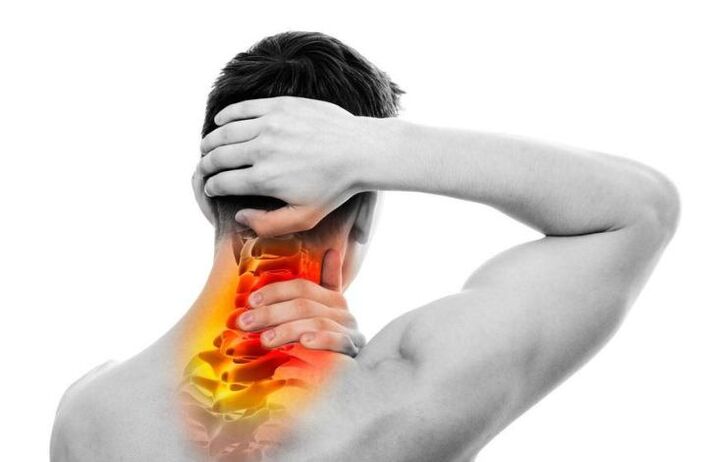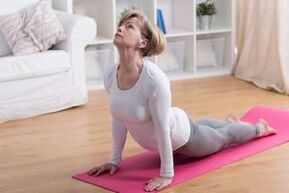Cervical spondylosis is a disease when damaged vertebrae put pressure on the discs. This leads to pain due to the pinched nerve fibers. Narrowed blood flow leads to dysfunction of internal organs. When this disease manifests in the cervical spine, it affects the blood supply to the soft tissues of the head and brain, disrupting the transmission of nerve impulses to the central nervous system.
Why does cervical osteonecrosis occur?

This condition can be caused by:
- Inherited tendency to reduce disc volume.
- Back, neck or limb injury.
- Weakened skeletal muscle.
- Difficult working conditions.
- Improper or excessive weight training.
- Infectious Diseases.
- The shoes cause gait changes, which increase the load on the spine.
- Unbalanced diet.
- Hereditary diseases.
Most causes of cervical osteonecrosis and its symptoms can be prevented.It is necessary to create the right conditions for work, as well as to choose physical activities that help strengthen the muscles that support the spine. But this is not always possible at the right time, because a person rarely thinks about a problem that does not yet exist.So you need to know what are the most common signs of cervical osteochondrosis:
- reduced range of motion;
- constant or sharp pain;
- spina bifida when moving the head;
- headache that does not go away with medication;
- numbness of one or more limbs;
- tremors or involuntary muscle contractions;
- dizziness, loss of coordination of movements or consciousness;
- tinnitus (ringing in the ears or hissing in the ears);
- problems remembering or using learned information;
- memory loss;
- problems with the work of the sphincter of the rectum and bladder neck.
Each osteonecrosis of the neck is unique and affects different functions of the body, so some symptoms may be absent. But the patient always has difficulty in turning his head, pain and when the condition gets worse, headache, dizziness.
How to diagnose disease at home

Pain from osteonecrosis can be pulsating, short-term and long-term, and constantly bother a person. When the neck is affected, the discomfort extends to the back of the neck and is usually located on the side of the working arm. In this case, the pain can be in both the neck and between the shoulder blades, and affect the entire arm.
The complexity of the diagnosis arises from the fact that discomfort can change over time, due to changes in body position, stress, or other reasons. Therefore, the first signs of osteonecrosis may be attributed to overactivity or muscle tension. But over time, the pain and stiffness become more frequent and intense, requiring identification of the cause and initiation of treatment.
It is quite difficult to independently determine the cause of pain in the cervical vertebrae at home.For the suspicion of osteonecrosis to be justified, other options must be ruled out. Usually, the pain is caused by muscle tension, sleeping in the wrong position, or when working. Therefore, it is necessary to improve these conditions to understand whether they are the main source of discomfort.
If neck problems persist, this is a serious symptom that could indicate osteonecrosis and other conditions, such as:
- tumor;
- infection;
- nerve root compression.
Therefore, you should consult your doctor and get an x-ray. This will let you know if there are injuries or other signs of outside influences.
After it became known that the neck was affected by osteonecrosis, regardless of the methods of information collection, the cause of the disease remained unclear. You can only independently determine violations of working conditions, electrical loads and injuries. The remaining diseases can be recognized only after a thorough examination - this is necessary, since an infection affecting the spine or other similar disorders will seriously endanger health and life.
How to treat osteonecrosis with drugs and folk remedies
Once diagnosed, you should adopt a treatment plan that your doctor will develop or create on your own. In selecting its views, it is important to emphasize an integrated approach to the selection of means and the systematic implementation of all recommendations.
What to do with cervical osteochondrosis:
- apply medicine;
- using folk remedies;
- conduct physical therapy;
- Make lifestyle changes to eliminate the underlying cause of the disease.
Medicines include:
- Oral and topical preparations help relieve pain and reduce inflammation, but do not contain steroids.
- Pain relievers containing corticosteroids.
- Muscle relaxants.
- Antidepressants (if the work of the central nervous system is impaired, causing a violation of the emotional background).
- Anti-inflammatory ointment.
- Patches for pain relief.
Folk methods include:
- Herbal decoction and infusion for oral administration. The effectiveness of funds depends on the raw materials used for them. These can be both general strengthening compounds that saturate the body with useful substances, as well as pain relievers or anti-inflammatory drugs.
- Compression - usually warming, to relieve neck spasms and allow the spine to return to its original position.
- Massage - rub folk remedies into the skin, often in combination with massage or self-massage. It has a different direction of action, but is commonly used to relieve pain, warm up, and relax muscles.

Physical therapy includes:
- Massage performed by a medical professional - medical procedures that have a beneficial effect on the spine and back muscles. In the case of a violation of the neck, you cannot use the services of a masseuse who specializes only in performing relaxation sessions.
- Self-massage - correctly performed movements help to warm up the neck muscles, relieve spasms and restore blood circulation in the neck and shoulder area.
- Improve working conditions, choose the right furniture to maintain proper posture, and in sedentary work - take frequent breaks when performing physical movements.
- Increase the number of walks, using shoes with shock-absorbing soles. Walking helps to place the correct load on the back, especially the lumbar region, whereby the clamps in the musculoskeletal muscles are removed, and the spine returns to its anatomically correct position.
- Conduct a warm-up in the morning, including exercises for the neck and shoulders and impact on other parts of the body. In this case, all movements are performed only with their own weight, or in rare cases, light weights are allowed.
- Sauna or shower - a visit to a steam room with a course of 10-12 times can significantly reduce muscle tension in the back and activate the body's metabolism.
- Procedures prescribed by a doctor and performed with the help of special equipment (electrophoresis, etc. ).
In addition, swimming in the pool is a good way to maintain optimal muscle tone, reduce spasms and eliminate muscle atrophy. This must be done continuously and should be started as soon as the inflammation is gone. The first few times should work for the shoulders with a moderate force, then gradually increase until swimming becomes a full-fledged exercise.
As recommended by your doctor, remission occurs quickly enough if the disease has not progressed to a moderate or severe form. But it's important to remember that even a complete disappearance of symptoms is not a sign of cure.















































